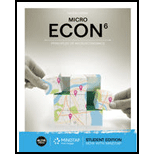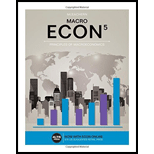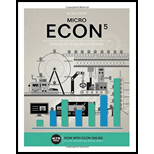
Concept explainers
(a)
Using the given data, calculate the merchandise
Concept introduction:
The periodical evaluation of trade balance i.e. the difference in the value between the imports and exports is known as Merchandise Trade Balance. The evaluation is performed on monthly and yearly basis.
Explanation of Solution
=
Here, the merchandise trade balance is -$2,075 billion. The negative balance indicates a
(b)
The balance on goods and services.
Concept introduction:
The periodical evaluation of trade balance i.e. the difference in the value between the imports and exports is known as Merchandise Trade Balance. The evaluation is performed on monthly and yearly basis.
Explanation of Solution
Import of Good and services =
Balance on Goods and Services =
Here, the balance on goods and services is -$100 billion. The negative balance indicates a trade deficit.
(c)
Using the given data, calculate the balance on current account.
Concept introduction:
The periodical evaluation of trade balance i.e. the difference in the value between the imports and exports is known as Merchandise Trade Balance. The evaluation is performed on monthly and yearly basis.
Explanation of Solution
Here, the balance on current account is $121.5 billion.
(d)
Using the given data, calculate the financial account balance.
Concept introduction:
The periodical evaluation of trade balance i.e. the difference in the value between the imports and exports is known as Merchandise Trade Balance. The evaluation is performed on monthly and yearly basis.
Explanation of Solution
Here, the financial account balance is -$145.0 billion. The negative balance indicates a trade deficit.
(e)
Using the given data, calculate the statistical discrepancy.
Concept Introduction:
The periodical evaluation of trade balance i.e. the difference in the value between the imports and exports is known as Merchandise Trade Balance. The evaluation is performed on monthly and yearly basis.
Explanation of Solution
Here, the statistical discrepancy is $23.5 billion.
Want to see more full solutions like this?
Chapter 20 Solutions
Econ Micro (book Only)
- Published in 1980, the book Free to Choose discusses how economists Milton Friedman and Rose Friedman proposed a one-sided view of the benefits of a voucher system. However, there are other economists who disagree about the potential effects of a voucher system.arrow_forwardThe following diagram illustrates the demand and marginal revenue curves facing a monopoly in an industry with no economies or diseconomies of scale. In the short and long run, MC = ATC. a. Calculate the values of profit, consumer surplus, and deadweight loss, and illustrate these on the graph. b. Repeat the calculations in part a, but now assume the monopoly is able to practice perfect price discrimination.arrow_forwardThe projects under the 'Build, Build, Build' program: how these projects improve connectivity and ease of doing business in the Philippines?arrow_forward
- Critically analyse the five (5) characteristics of Ubuntu and provide examples of how they apply to the National Health Insurance (NHI) in South Africa.arrow_forwardCritically analyse the five (5) characteristics of Ubuntu and provide examples of how they apply to the National Health Insurance (NHI) in South Africa.arrow_forwardOutline the nine (9) consumer rights as specified in the Consumer Rights Act in South Africa.arrow_forward


 Principles of Economics 2eEconomicsISBN:9781947172364Author:Steven A. Greenlaw; David ShapiroPublisher:OpenStax
Principles of Economics 2eEconomicsISBN:9781947172364Author:Steven A. Greenlaw; David ShapiroPublisher:OpenStax Brief Principles of Macroeconomics (MindTap Cours...EconomicsISBN:9781337091985Author:N. Gregory MankiwPublisher:Cengage Learning
Brief Principles of Macroeconomics (MindTap Cours...EconomicsISBN:9781337091985Author:N. Gregory MankiwPublisher:Cengage Learning





